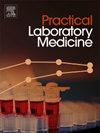上海及其他地区遗传性听力损失基因检测的外部质量评价
IF 1.3
Q3 MEDICAL LABORATORY TECHNOLOGY
引用次数: 0
摘要
目的遗传性听力损失是人类最常见的先天缺陷之一。孕妇和新生儿基因筛查可提供产前干预或早期诊断和治疗指导。目前,这种筛网已得到广泛应用;然而,其准确性和可靠性尚未确定。这项开创性研究的目的是评估上海和其他地区临床实验室在分析与听力损失相关的遗传变异方面的表现。方法EQA项目每年实施2次。我们以正常全血为基质,用来自不同细胞系的基因组DNA生成了一个由五个干血斑点组成的样本板。该小组包括4个样本,其中包含GJB2, GJB3, SLC26A4的9种不同致病变异以及线粒体DNA (mt DNA)和1个野生型样本。该小组被分发到参与实验室进行遗传分析,并对结果进行比较和评分。结果2023年分别有30家和29家临床实验室参与了两次EQA计划。28个(93.33%)和27个(93.10%)的实验室达到了可接受或优异的绩效评分(≥80)。第一个EQA方案有10个错误,8个假阴性,2个假阳性;第二个EQA方案有7个错误,5个假阴性,2个假阳性。结论国内大部分耳聋相关基因的临床遗传分析较为满意,但部分实验室有待进一步完善。此外,外部质量评价是监测临床实验室绩效的重要方法。本文章由计算机程序翻译,如有差异,请以英文原文为准。
External quality assessment of genetic testing for hereditary hearing loss in Shanghai and other regions
Objectives
Hereditary hearing loss is one of the most common birth defects in humans. Genetic screen in pregnant women and newborns could provide prenatal intervention or guidance on the early diagnosis and treatment. Currently, this screen has been widely applied; however, its accuracy and reliability have not been determined. The objective of this pioneering study was to evaluate the performance of clinical laboratories in Shanghai and other regions for their ability to analyze the genetic variants related with hearing loss.
Methods
The EQA program were carried out twice a year. We generated a sample panel consisting of five dry blood spots with genomic DNA from different cell lines with normal whole blood as the matrix. The panel included four samples with nine different pathogenic variants of GJB2, GJB3, SLC26A4 as well as mitochondria DNA (mt DNA) and one wild type sample. The panel was distributed to participant laboratories for genetic analysis, and the results were compared and scored.
Results
Thirty and twenty-nine clinical laboratories participated in the two EQA scheme in 2023, respectively. 28 (93.33 %) and 27 (93.10 %) laboratories achieved an acceptable or superior performance score(≥80). There were ten errors with eight false-negative and two false-positive results in the first EQA scheme, and seven errors with five false-negative and two false-positive in the second EQA scheme.
Conclusions
The results indicate that the majority of the clinical genetic analysis of deafness-related genes were satisfactory in China, while some participant laboratories needed further improvement. In addition, external quality assessment was demonstrated as an important method for monitoring the performance of clinical laboratories.
求助全文
通过发布文献求助,成功后即可免费获取论文全文。
去求助
来源期刊

Practical Laboratory Medicine
Health Professions-Radiological and Ultrasound Technology
CiteScore
3.50
自引率
0.00%
发文量
40
审稿时长
7 weeks
期刊介绍:
Practical Laboratory Medicine is a high-quality, peer-reviewed, international open-access journal publishing original research, new methods and critical evaluations, case reports and short papers in the fields of clinical chemistry and laboratory medicine. The objective of the journal is to provide practical information of immediate relevance to workers in clinical laboratories. The primary scope of the journal covers clinical chemistry, hematology, molecular biology and genetics relevant to laboratory medicine, microbiology, immunology, therapeutic drug monitoring and toxicology, laboratory management and informatics. We welcome papers which describe critical evaluations of biomarkers and their role in the diagnosis and treatment of clinically significant disease, validation of commercial and in-house IVD methods, method comparisons, interference reports, the development of new reagents and reference materials, reference range studies and regulatory compliance reports. Manuscripts describing the development of new methods applicable to laboratory medicine (including point-of-care testing) are particularly encouraged, even if preliminary or small scale.
 求助内容:
求助内容: 应助结果提醒方式:
应助结果提醒方式:


